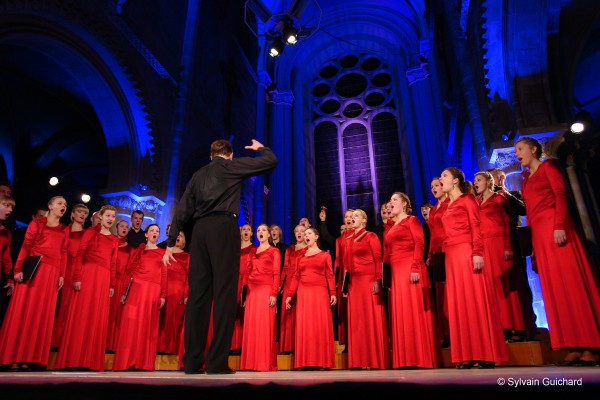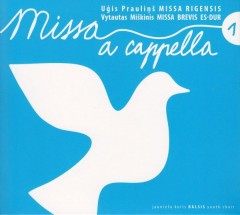
Youth Choir “BALSIS” singing at the Polyfollia festival in Saint-Lo, France in 2010. Photo: Sylvain Guichard.

Latvian youth choir BALSIS (Voices) has created a new repertoire and recording project, Missa a cappella, to commission and record new masses.
Balsis Artistic Director and Conductor Ints Teterovskis says about masses: “The genre of the a cappella Mass is undeniably one of the cornerstones in the development of choral polyphony, and is one on which our modern composers focus relatively rarely.” Masses are also performed in the the Latin language, very benevolent to singers, and a language which, although no longer spoken or written, comes back to life in sacred music, this project, and in the project’s recordings.
On listening to the new disk, it’s hard to know whether to be more enthusiastic about the repertoire or its performance. Especially with modern works, a good performance is critical. As a musical jokester once quipped: “No matter how bad the performance, Beethoven remains Beethoven”. Contemporary composers, without the benefits of that kind of fame, need to rely on the performance. But in this case, the composers won’t be losing any sleep, as the BALSIS recording is first rate.
It is not surprising that nations that value singing, such as the Baltic States, (their song festivals receiving a UNESCO heritage designation), would also have excellent composers to create for their choirs. There are many similarities among these two composers: they are of a similar age, both works are from the 21st century, both are a cappella settings of the same text. Both are highly regarded in their homelands, both serving their art beyond the composer’s studio, Prauliņš for many years as chair of the Latvian Composers’ Association, and Miškinis as head of the choir division of the Lithuanian Academy of Music and Theatre.
But their styles differ markedly. Miškinis likes to use small motives that repeat, (but without being “minimalist”), spinnning layers of these rhythmic fragments into massive dissonant chords, creating impressive sonorific effects. For Prauliņš, it seems that he has a new idea in every bar, understanding well the language of the voice, and then demanding everything from it. The work is very interesting and compelling, almost like browsing through a catalogue of vocal effects. But these effects aren’t gratuitous, unlike a mediocre chef who adds every imaginable spice to his stew, and hopes for the best. Prauliņš’ effects are idiomatic and appropriate, resulting in a powerful and impressive texture. Both works are such demanding showpieces, that only the finest choirs will attempt them, and then only if they have a lot of time to spare.
To sing our folk songs is one thing. To effectively perform demanding and complicated new (modern and unfamiliar) works is quite a different undertaking. When artistic and technical limits are stretched, through high tessituras, through technical passages, in sections without a sense of key, in multi-voiced dissonant chords, one might expect somewhere, somehow, an awkward or uncomfortable moment. But it doesn’t happen with BALSIS: every chord is flawlessly in tune, every phrase and word more clear than crystal, regardless in what range, every technical hurdle easily cleared.
The ensemble is precise and musical ideas are carefully and logically worked out, yet natural and familiar. The sound engineers with their buttons can create pretty sounds, massive fortissimi and barely audible pianissimi, but there are no buttons for a gentle and fragile pianissimo, or an energetic and powerful fortissimo, or for phrases that effortlessly flow one into another. Only an outstanding choir like BALSIS can do that.
It’s worth mentioning that youth choirs operate under a certain handicap: the fleeting nature of youth. Where a professional athlete of 40, a rarity to begin with, is perceived as a senior citizen, the career of a singer in a youth choir is understandably even shorter. Unfortunately, along with maturity come the obligations and commitments of family and career, and choristers are no longer able to commit to learn 8 full programs a year, (often memorized), participate in 65 concerts, or travel to competitions and festivals. In Canada, where it isn’t uncommon for a chorister to sing with the same choir for 50 and more years, a choir whose membership changes dramatically every year would be unique. Even more surprising is that the choir’s skill level remains extraordinarily high, and that year after year, outstanding concerts and recordings are offered, even though the musical directors often have to start each time from scratch.
The admirable Missa a cappella project continues, with the second recording projected to have the new Missa Liberationis by Canadian composer Peter-Anthony Togni, which was premiered in Rīga in December 2011, and a mass by international star Pēteris Vasks, and an expected third disk with works by Rihards Dubra and Ēriks Ešenvalds.
Congratulations to the angels of BALSIS for this fabulous disk, their continuing outstanding work under the abovementioned circumstances, and for this worthy project. But it’s important to acknowledge the role of the “chief angel”, tireless artistic director Ints Teterovskis, who is the producer of this disk and the author of the Missa a capppella project. Bravo Ints!
The CD is available for purchase online at www.openingday.com
Details
Missa a cappella
BALSIS
Latvia: Musica Baltica, 2011
Track listing:
Missa a cappella I
Uģis Prauliņš Missa rigensis (2002)
1. Kyrie
2. Gloria
3. Credo
4. Sanctus
5. Agnus Dei
Vytautas Miškinis Missa Brevis Es-Dur (2010)
6. Kyrie
7. Gloria
8. Credo
9. Sanctus
10. Benedictus
11. Agnus Dei
© 1995-2024 Latvians Online
Please contact us for editorial queries, or for permission to republish material. Disclaimer: The content of Web sites to which Latvians Online provides links does not necessarily reflect the opinion of Latvians Online, its staff or its sponsors.




